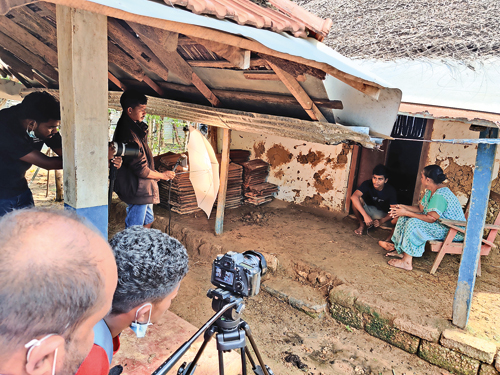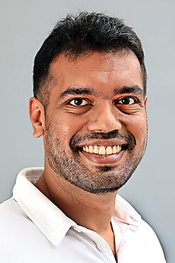From ashes of war rise art and healing

A film in the making: Taking the stories of humble people to the silver screen
Once upon a time, the very aridness of Mullaitivu was always its charm; palmyrah clusters grew copse-like in the middle of paddy fields and on sand dunes, were reflected on cerulean lagoons alongside colourful gopurams, the salt pans shimmered and the flamingoes crowded like candy floss.
Forty years ago, however, all that was blighted and the sunbaked landscapes became associated with war-torn emptiness; not blue-skied paradise and genteel, northern hospitality. The land still seems scorched with raw sienna earth, the palmyrah not quite able to weave its erstwhile green magic.
In the quiet little village of Vattrapalai, however, a new dawn tints the sky with the golden pink of hope. The Vattrapalai International Institute of Art and Film (VIIAF) wants to heal the wounded. Their poultice? Art.
Talking to Nishanthan Niruthan, Managing Director, one gleans that the VIIAF was born as a beacon for underprivileged youth where they can master any form of art they would like to- and tell their stories creatively thereby empowering themselves and their communities. The students come from as far apart as Matara, Nuwara Eliya, Batticaloa, Polonnaruwa, Hatton, Ampara, Jaffna and Kilinochchi. Currently there are around 80 working on their projects.
Underprivileged does not mean poverty, says Nish, as say, a middle class girl would be eligible if any taboos restrain her from practising any art. And when they say ‘any art’, they mean it.
Nish is an Indian-born Sri Lankan film executive. He says that the VIIAF, working with another NGO, The Social Architects, recruits students from the grassroots level from far-flung corners of the island. No barriers of race, language or creed intervene, and the courses will be structured to meet the specific demands of any youth who walks in. VIIAF will help out “anyone who wants to create something but does not have the means to create it.”
Popular arts include filmmaking, street drama, music, painting and poetry, while documentary filmmaking and animation are being newly added.

Nishanthan Niruthan
Two main goals underpin the VIIAF. One is that the youth will achieve reconciliation (having gone through war but also poverty, the tsunami and other traumas) while healing personal wounds (from all kinds of abuse) and the other that they would take Sri Lankan arts, especially film, up to global heights.
The teachers are veterans from either side of the Palk Strait. Dharmasiri Bandaranayake, playwright and film director, teaches street drama while Nish recently got friends from Mumbai – expert film editors to hold an editing workshop via Zoom. While there is no permanent staff, professionals get drawn in as and when required.
Native folk art on the brink, like rukada puppetry from the South and Kolattam (an Indian folk art the coastal Muslims practise with a dollop of Persian flair), are revived amidst the students. Nish says that also, in Mullaitivu, are young students who have developed a local form of bonsai.
With his Indian antecedents Nish knows what a ‘binding force’ art can be. “That’s why cinema is so huge in India because in a movie theatre you don’t know whether the person sitting next to you is Hindu or Muslim or Christian or rich or poor.”
“Art creates a space where everyone is equal. And that was super fascinating for me,” he mulls, “that’s what I want to explore with the institute, giving them that camaraderie that comes with creating art which is just as important as the creating.”
March, fingers crossed, will see the VIIAF’s first International Arts & Film Festival amidst the colourful devotional bustle and haunting, reedy nadaswaram fluting of Panguni Thingal, an old temple festival which venerates Kannaki Amman who also morphs into the Sinhala Buddhist goddess of chastity, Pattini.
As chariots parade and Kavadi dancers sway to an ancient, primeval call, VIIAF plans to hatch another annual tradition in tandem. Already quite a number of movies are lined up to be shown: a story of the aftermath of the war from Anuradhapura; war-related poverty in the East; the tsunami; land issues in Hatton and documentary paeans to the beauty of the sea.
But the most gratifying moments for Nish are when VIIAF youths from a potpourri of backgrounds would decide to come together to do a street drama, or pay long visits to their new friends living in ethnically homogenous pockets- almost alien worlds till then. “Reconciliation like that, should come from them,” he enthuses.
Healing is twofold – the social and the personal. The former is where, in groups, through art and discussion, they get the victims of collective trauma like war to tell their stories, a process of catharsis where they come out of their shells with their stories creatively and are empowered.
Those with individual trauma, often victims of abuse, are dealt with one on one. In creating art about their traumatic experiences, these students are encouraged to use metaphors for what ravaged them – “like the Japanese created Godzilla after the atomic bombings of Hiroshima” rather than grappling with graphic details of trauma. Metaphorizing their trauma using a form of art that is new to them is powerful catharsis.
The tutors will fine hone the technical aspects of the stories they create but “leave the content completely untouched”.
Nish says that “sometimes (the latter category of) students don’t want their movie released, they just want to make it. Sometimes they just want our help drawing something, painting, writing a poem, and read it to themselves at night.”
Some already have found their voice and put their past behind them.
But while the VIIAF’s work is assuaging grief and healing scars, Nish remains circumspect about defining its future.
“This is just a seed we have planted together; the stem is shooting up. Let’s wait and see where the tree finally goes,” he smiles.


